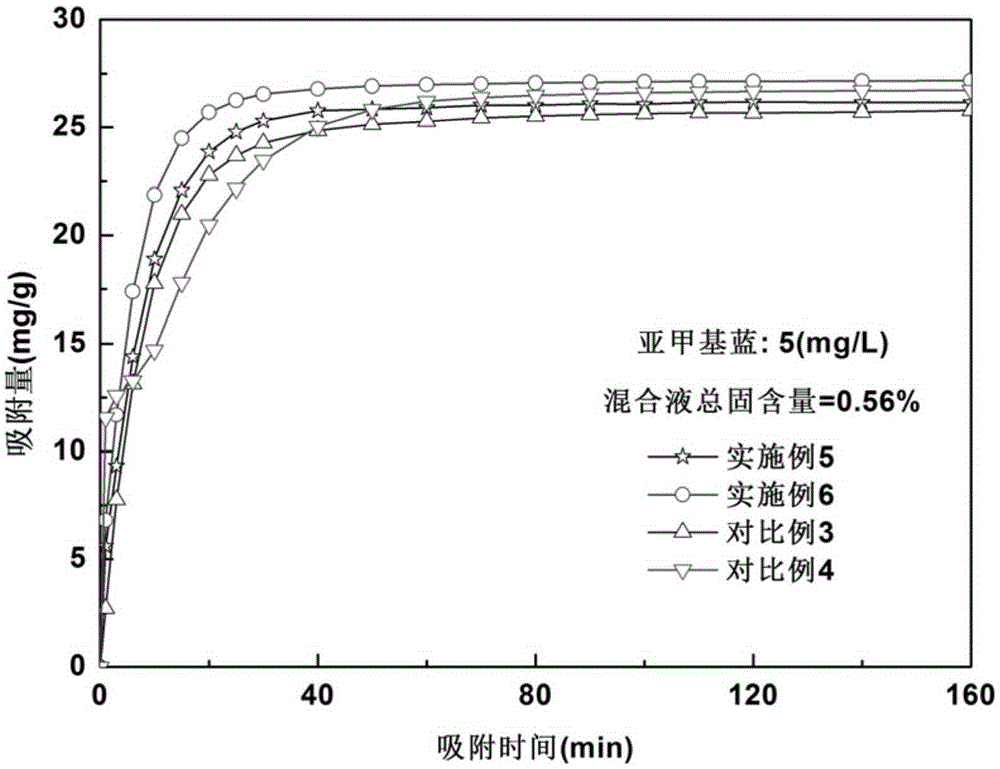Preparation method of nano-crystalline cellulose-based composite aerogel type organic dye absorption material
A technology of nanocellulose and composite airgel, applied in chemical instruments and methods, colloid chemistry, colloid chemistry, etc., can solve the problems of water-soluble dye adsorption performance and selectivity to be further improved, easy swelling, loss of mechanical properties, etc.
- Summary
- Abstract
- Description
- Claims
- Application Information
AI Technical Summary
Problems solved by technology
Method used
Image
Examples
Embodiment 1
[0019] Cationic nanocellulose and chitosan 1:1 (w / w) composite airgel was prepared as follows:
[0020] Disperse 1g of bamboo pulp in 5% NaOH solution, add 2.9g of 2,3-epoxypropyltrimethylammonium chloride and stir at 25°C to make it evenly mixed, then react at 65°C for 6h. After the reaction is completed, adjust the pH to 7 with dilute hydrochloric acid, filter with suction, wash with a large amount of distilled water until neutral, and finally polish the fiber suspension through a high-pressure homogenizer to obtain a positively charged NFC dispersion on the surface;
[0021] The mixture of cationic nanocellulose and chitosan (solid mass ratio = 1:1 (w / w)) was placed at -60°C for 4 hours and then freeze-dried, then soaked in 0.5% epichlorohydrin (cross-linked agent) in a 2wt% sodium hydroxide solution at 40° C. for 2 hours, then freeze-dry again. Its performance is shown in Table 1 and figure 1 .
Embodiment 2
[0023] Cationic nanocellulose and chitosan 2:1 (w / w) composite aerogels were prepared as follows:
[0024] Disperse 1g of bamboo pulp in 5% NaOH solution, add 2.9g of 2,3-epoxypropyltrimethylammonium chloride and stir at 25°C to make it evenly mixed, then react at 65°C for 6h. After the reaction is completed, adjust the pH to 7 with dilute hydrochloric acid, filter with suction, wash with a large amount of distilled water until neutral, and finally polish the fiber suspension through a high-pressure homogenizer to obtain a positively charged NFC dispersion on the surface;
[0025] The mixture of cationic nanocellulose and chitosan (solid mass ratio = 2:1 (w / w)) was placed at -60°C for 4 hours and then freeze-dried, then soaked in 0.5% epichlorohydrin (cross-linked agent) in a 2wt% sodium hydroxide solution at 40° C. for 2 hours, then freeze-dry again. Its performance is shown in Table 1 and figure 1 .
Embodiment 3
[0027] Low-charge cationic nanocellulose was prepared as follows:
[0028] Disperse 1g of bamboo pulp in 5% NaOH solution, add 2.9g of 2,3-epoxypropyltrimethylammonium chloride and stir at 25°C to make it evenly mixed, then react at 65°C for 6h. After the reaction, adjust the pH to 7 with dilute hydrochloric acid, filter with suction, wash with a large amount of distilled water until neutral, and finally polish the fiber suspension with a high-pressure homogenizer to obtain a positively charged NFC dispersion on the surface.
PUM
| Property | Measurement | Unit |
|---|---|---|
| density | aaaaa | aaaaa |
| porosity | aaaaa | aaaaa |
| porosity | aaaaa | aaaaa |
Abstract
Description
Claims
Application Information
 Login to View More
Login to View More - R&D
- Intellectual Property
- Life Sciences
- Materials
- Tech Scout
- Unparalleled Data Quality
- Higher Quality Content
- 60% Fewer Hallucinations
Browse by: Latest US Patents, China's latest patents, Technical Efficacy Thesaurus, Application Domain, Technology Topic, Popular Technical Reports.
© 2025 PatSnap. All rights reserved.Legal|Privacy policy|Modern Slavery Act Transparency Statement|Sitemap|About US| Contact US: help@patsnap.com


